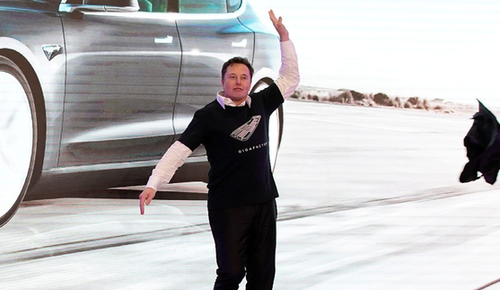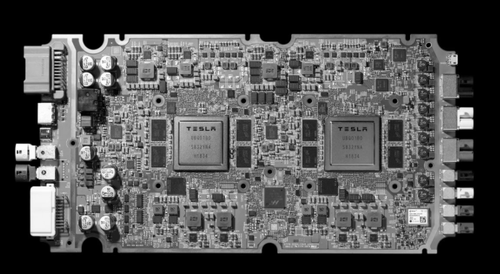Tesla Reportedly “Scrambling” For Instrument Cluster Supplies
We may have a little more insight as to reports yesterday that Tesla was pre-paying for semiconductor parts to secure supply. Yesterday, we guessed that Tesla’s new “pre-payment” terms could be a result of suppliers showing little patience with the automaker, who has over $6 billion in payables.
But a new report overnight from DigiTimes Asia sheds more light on the situation, leading us to believe that Tesla could simply be short of supplies and desperately in need of parts to be able to hit production targets.
The report notes that Tesla is “scrambling” for instrument cluster supplies:
Tesla is reportedly approaching IC suppliers in Taiwan, Korea and the US, seeking to secure steady supplies of automotive chips with advance payments, according to industry sources.
It might be difficult for Tesla to achieve significant results, given the IT and automotive supply chain makers have been competing for the foundry capacity since the fourth quarter of 2020, said the sources.
In the first quarter of 2021, there were reports saying that Tesla had already piled up enough IC parts for its target production of 500,000 EVs.
However, speculations have emerged recently indicating the firm is short of semiconductor parts, and it has even admitted that it has been feeling the pinch.
Additionally, the reasoning behind Tesla recently choosing to remove radar from its vehicles – which caused it to lose Consumer Reports’ “Top Pick” status this week – may also have to do more with a lack of supply than innovation. “The firm’s recent decision to remove mmWave radar sensors from its EVs highlights the shortage of its IC parts,” the DigiTimes report noted.
We noted yesterday that Tesla was reportedly in talks with semi companies in Taiwan, South Korea and the US. The chips that Tesla uses for its vehicles are mainly made in Taiwan and South Korea. Some chipmakers have been allowing large customers to make upfront deposits to secure orders at fixed prices. While that practice is outside the norm generally, it has come to prominence once again due to the supply shortage.
CW Chung, an analyst at Nomura, noted that companies like Samsung can change contracting arrangements with companies like Tesla who seek specialized chips: “Given the current capacity shortage, Samsung may give dedicated capacity to companies like Tesla, which uses chips with a longer life cycle.”
Recall, we also noted days ago when Tesla said it was ditching radar in favor of using a “camera-focused Autopilot system” and that the change is going to apply to both Model 3 and Model Y vehicles in North America, starting this month.
The move comes as scrutiny of both “Autopilot” and “Full Self Driving” – two features that clearly don’t live up to their name the way they are labeled – has intensified. Additionally, as CNBC noted, “radar sensors are relatively expensive” and this could be yet another cost for Tesla to try and cut.
“Pure vision Autopilot is now rolling out in North America,” Tesla CEO Elon Musk said on Twitter, referring to the change, earlier this week. Recall, Tesla had to quickly shelve its last Full Self Driving beta after numerous humiliating videos surfaced of the software having repeated issues and quickly went viral. The Full Self Driving beta v8.2 was thrashed by critics like Road and Track who called it “laughably bad” and “potentially dangerous”.
“If you think we’re anywhere near fully autonomous cars, this video might convince you otherwise,” Road and Track wrote about Tesla’s Full Self Driving feature. The article referred to the feature as “morally dubious, technologically limited, and potentially dangerous”.
Tesla’s blog on its website said:
We are continuing the transition to Tesla Vision, our camera-based Autopilot system. Beginning with deliveries in May 2021, Model 3 and Model Y vehicles built for the North American market will no longer be equipped with radar. Instead, these will be the first Tesla vehicles to rely on camera vision and neural net processing to deliver Autopilot, Full-Self Driving and certain active safety features. Customers who ordered before May 2021 and are matched to a car with Tesla Vision will be notified of the change through their Tesla Accounts prior to delivery.
For a short period during this transition, cars with Tesla Vision may be delivered with some features temporarily limited or inactive, including:
- Autosteer will be limited to a maximum speed of 75 mph and a longer minimum following distance.
- Smart Summon (if equipped) and Emergency Lane Departure Avoidance may be disabled at delivery.
In the weeks ahead, we’ll start restoring these features via a series of over-the-air software updates. All other available Autopilot and Full Self-Driving features will be active at delivery, depending on order configuration.
Tyler Durden
Fri, 05/28/2021 – 14:03
via ZeroHedge News https://ift.tt/3oYNcep Tyler Durden


